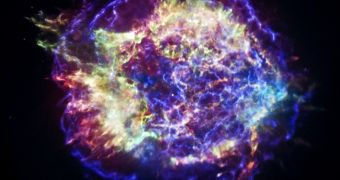Data from the NASA Chandra X-ray Observatory (CXO) is now being used by researchers at the Smithsonian Institution to create a three-dimensional viewer tool, capable of showcasing the renowned supernova remnant Cassiopeia A to wider audiences.
This work is part of a larger-scale effort by Smithsonian officials to digitize a part of their impressive collection of items, objects, and artifacts. The 3D viewer is scheduled to be unveiled this week, and it will allow users to view the supernova remnant from any angle.
The unique 3D model was assembled by astronomers with the American space agency from data collected by the CXO, the NASA Spitzer Space Telescope, and a large number of ground-based optical observatories. Cassiopeia A will be the only astronomical object digitized by the Smithsonian.
To mark the occasion, NASA has just released a new image (attached) of the remnant, which has been specially processed before inclusion in the 3D viewer. X-rays of low energy are shown in red, those of medium energy in green, and those of the highest energy in blue.
These different energy bands will help astronomers gain new insights into the size of the star that created the 300-year-old supernova, the object's chemical composition, as well as the mechanism of the actual explosion.
Supernova events occur when massive stars several times the size of the Sun reach the ends of their burning cycle. Their cores become unable to support nuclear fusion due to lack of hydrogen, so the outer layers of the objects are blown up in the most intense and energetic type of explosion.
The cores of these stars endure, either as black holes or neutron stars, depending on their original mass and the characteristics of the blast. Often, the material ejected from the original star goes on to form beautiful nebulae, which are illuminated by radiations from its core.
“The collaboration with this new Smithsonian 3D project will allow the astronomical data collected on Cassiopeia A […] to be featured and highlighted in an open-access program – a major innovation in digital technologies with public, education, and research-based impacts,” NASA experts say in a statement.
“Providing this newly formatted data in an open source framework with finely-tuned contextual materials will greatly broaden awareness and participation for general public, teacher, student and researcher audiences,” they conclude.

 14 DAY TRIAL //
14 DAY TRIAL //